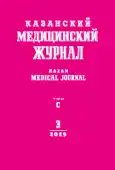Impact of myofunctional disorders of the maxillofacial area on the formation of occlusion pathology in children
- Authors: Ignateva LA1, Khamitova NK.1
-
Affiliations:
- Kazan State Medical University
- Issue: Vol 100, No 3 (2019)
- Pages: 422-425
- Section: Theoretical and clinical medicine
- URL: https://bakhtiniada.ru/kazanmedj/article/view/13297
- DOI: https://doi.org/10.17816/KMJ2019-422
- ID: 13297
Cite item
Full Text
Abstract
Myodynamic balance of the muscles of maxillofacial area provides required conditions for normal development of dentoalveolar system. Dysfunction of the muscles of facial and oral area is a significant ethiopathogenetic factor of development of anomalies of tooth position and development of upper and lower jaws. Among such factors the most prevalent habits are sucking fingers, mouth breathing (in genetically, anatomically and physiologically caused absence of nasal breathing), incorrect lip seal and infantile swallowing. Position of the tongue in mouth breathing is of particular importance as positioning the tongue between the dental arches causes significant vestibular inclination of the upper incisors. As a result of these changes disocclusion is formed in vertical plane. Additional pressure of stretched buccal muscles during mouth breathing causes narrowing of the dental arches. It is required to mention that many researchers pay attention to decreased bioelectrical activity of masseters in electromyographic study in patients with occlusion anomalies. Formation of this pathology influences not only the general health state (disorder of nasal breathing, swallowing, chewing, sound pronouncing and posture) but also social adaptation of a child. Due to this children require complex approach to the diagnosis and correction of myofanctional disorders of maxillofacial area.
Full Text
##article.viewOnOriginalSite##About the authors
L A Ignateva
Kazan State Medical University
Author for correspondence.
Email: ign-lilya@yandex.ru
Russian Federation, Kazan, Russia
N Kh Khamitova
Kazan State Medical University
Email: ign-lilya@yandex.ru
Russian Federation, Kazan, Russia
References
- Kosyuga S.Yu. Medical and social study of children of early school age as a scientific grounding of prophylaxis programme for teeth and jaw abnormalities requiring orthodontic treatment. Medicinskiy al`manakh. 2017; (2): 158–161. (In Russ.) doi: 10.21145/2499-9954-2017-2-158-161.
- Al-Abdallah M. Prevalence and distribution of dental anomalies: a comparison between maxillary and mandibular tooth agenesis. Am. J. Orthod. Dentofacial. Orthop. 2015; 148: 793–798. doi: 10.1016/j.ajodo.2015.05.024.
- Gontarev S.N. Prevalence of dentoalveolar anomalies and dental arch defects in children and adolescents of Belgorod region. Evaluation of orthodontic care to the population. Nauchny`e vedomosti Belgorodskogo gosudarstvennogo universiteta Seriya: Meditsina. Farmatsiya. 2011; (10): 212–217. (In Russ.)
- Koteeva E.I. Vredny`e privy`chki u detej i ih posledstviya. (Harmful habits of children and their consequences.) Sbornik nauchny`kh trudov molody`kh ucheny`kh i specialistov. 2014; 18–23. (In Russ.)
- Mason R.M. A retrospective and prospective view of orofacial myology. Int. J. Orofacial. Myology. 2015; 31: 5–14. PMID: 16739708.
- Silin A.V., Satygo E.A. The condition of the functional system of maxillo-facial area for children in the early period of removable bite. Rossiyskiy stomatologicheskiy zhurnal. 2013; (2): 27–29. (In Russ.)
- Arkhipova E.F. The effects of normal mouth breathing in children. Sovremennoe doshkol`noe obrazovanie. Teoriya i praktika. 2017; (3): 36–45. (In Russ.)
- Zawawi K.H. The role of mandibular third molars on lower anterior teeth crowding and relapse after orthodontic treatment: a systematic review. Sci. World J. 2014; 3: 615–619. doi: 10.1155/2014/615429.
- Garretto A.L. Orofacial myofunctional disorders related to malocclusion. Int. J. Orofacial. Myology. 2001; 27: 44–54. PMID: 11892370.
- Grabowski R. Interrelation between occlusal findings and orofacial myofunctional status in primary and mixed dentition: Part III: Interrelation between malocclusions and orofacial dysfunctions. J. Orofac. Orthop. 2017; 68 (6): 462–476. doi: 10.1007/s00056-007-0717-y.
- Sommer I. Review of self-reported instruments that measure sleep dysfunction in patients suffering from temporomandibular disorders and/or orofacial pain. PlumX Metrics. 2015; 16: 27–38. doi: 10.1016/j.sleep.2014.07.023.
- Tokarevich I.V. The analysis of the state of masseter and temporalis muscles with myofunctional disorders in children 7–8 years old and the evaluation of the effectiveness of orthodontic correction methods. Vestnik BGMU. 2013; (4): 10–22. (In Russ.)
- Iskhakova G.R. Functional status of masticatory muscles in adult patients with vertical incisal disocclusion. Medicinskiy vestnik Bashkortostana. 2013; (3): 88–90. (In Russ.)
Supplementary files






